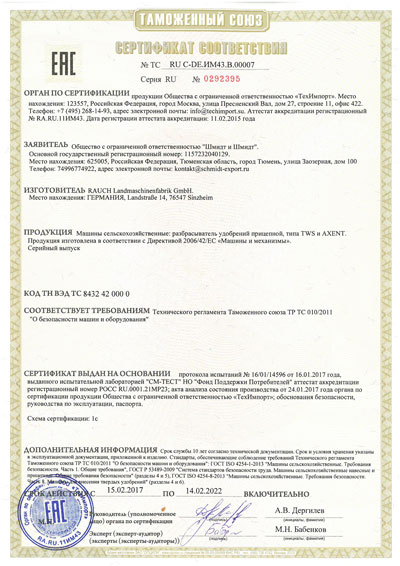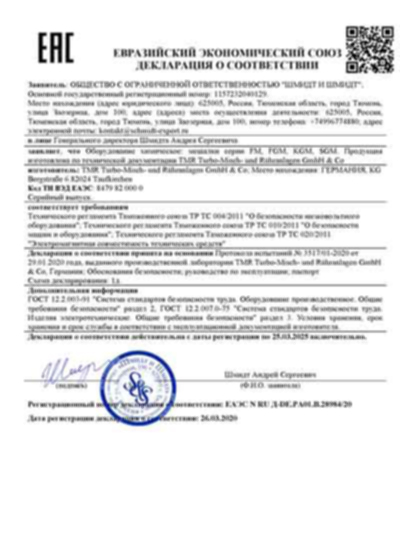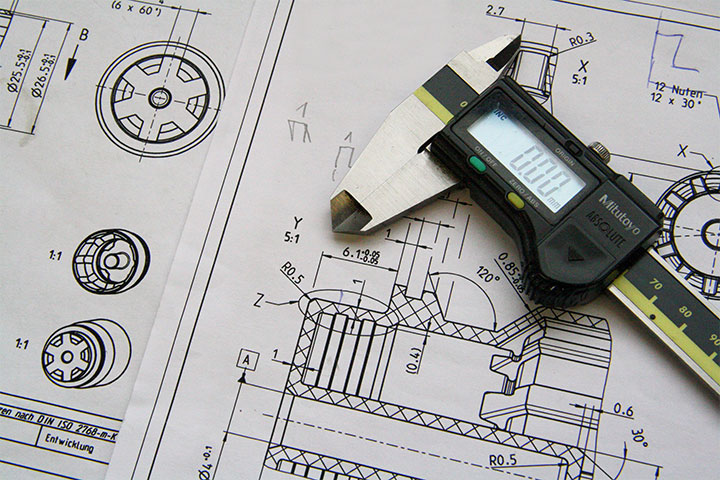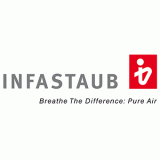
The EAC Certificate of Conformity to Technical Regulations of the Eurasian Economic Union (EAEU) constitutes attestation of conformity that products fulfil the specified requirements of the harmonized technical regulations (TR CU) of the EAEU member states. The former Russian TR certification procedure served as the reference model for the establishment of this unified certification system.
The Eurasian Economic Union (EAEU) is an intergovernmental economic union comprising Belarus, Russia, Kyrgyzstan, Kazakhstan and Armenia. It constitutes a free trade area among the participating states. Within the territory of the EAEU, a common customs tariff, uniform trade rules and harmonized technical regulations apply.
Products for which conformity with the specified requirements of the technical regulations has been attested by means of an EAEU Certificate may be placed on the market and moved freely across the customs territories of all member states of the Eurasian Economic Union, without the need for additional national conformity assessment procedures, such as GOST-R, TR or GOST-K certificates.
Certificates within the framework of the EAEU may be issued by an independent third-party conformity assessment body accredited in a member state of the Eurasian Economic Union, following determination that the relevant requirements are fulfilled. The requirements applicable to accredited certification bodies are defined in GOST ISO/IEC 17065:2012 Conformity assessment — Requirements for bodies certifying products, processes and services.
Legal framework for EAC certification
The legal basis for the EAC certification involves following documents:
- The board decision of the EAEU commission No. 319 from 18.06.2010 — on the technical regulations of the EAEU;
- The agreement on common principles and rules of technical regulation in the Republic of Belarus, Republic of Kazakhstan and the Russian Federation 18.11.2010 — on the coordinated principles of technical regulation;
- The decision of the board of the customs union commission No. 620 from 07.04.2011
As a result of the harmonization of national safety standards, the previous national Technical Regulations such as Russian GOST-R, and TR certification were gradually phased out and substituted by the new Technical Regulations of the EAEU - TR CU in every industrial sector. In addition to the EAC certification, the EAC Declaration of Conformity has also been introduced in the customs union as a simpler and less expensive form of proof of conformity.
The EAC certification process is consistent for all member states of the EAEU. The certificate of the EAEU has a standardized format and application process in accordance with the board decision of the Eurasian Economic commission No. 896 from 09.12.2011.
EAC certificate contains the following information:
Regarding its content, the EAC certificate of the EAEU is identical with the TR certificate and includes the following information:
- address and name of the manufacturer
- names of certified products
- customs tariff number
- applied standards of Technical Regulation
- information about the testing center
- period of validity
- registration number
- information on the conformity assessment body
The EAC certificates of the EAEU are valid throughout the customs territory of all EAEU member states for up to 5 years. The issued EAC certificates are registered in the uniform register of the EAEU. In addition to EAC certification, the EAC Declaration of Conformity is also required to confirm compliance of products with the Technical Regulations of the EAEU member states.
Scope of application of the EAC certificate
An EAC certificate or an EAC declaration is required within the Eurasian Economic Union (EAEU) for all products included in the Unified List of Products Subject to Mandatory Conformity Assessment in accordance with Decision No. 620 of the Commission of the Customs Union of 7 April 2011. This list specifies which product groups may not be placed on the market, imported or distributed without a valid EAC certificate.
Products not included in this list remain subject to national conformity assessment procedures for certification upon import and distribution in the individual Member States. Therefore, it is essential for manufacturers and exporters to determine in advance whether their objects of conformity assessment require an EAC certificate or an EAC declaration, in order to prevent delays and mitigate legal risks in market access.
Technical Regulations TR CU and TR EAEU
So far, 48 technical regulations have been adopted in the Eurasian Economic Union, which serve as the basis for EAC certification. Several sets of rules are currently being developed or are already being discussed at the Union level.
The technical regulations TR CU and TR EAEU are basically the counterpart of Eureopean CE directives, or more precisely EU regulations. TR CU is abbreviation for Technical Regulations of the Customs Union. TR EAEU is an abbreviation for Technical Regulations of the Eurasian Economic Union, similiar to the designation of CE directives e.g. Directives 2006/42/EC and 2011/65/EU. More on this topic you can find in our articles: "Which one is correct: TR CU certificate or EAC certificate?" and "Differences between EAC Certificate and EAC declaration".
The technical regulations set minimum requirements for the safety of the respective products. The conformity of the products with the regulations is declared by EAC certificate by the manufacturer or its representative. After successful conformity assessment, the products are marked with the EAC conformity mark. The EAC marking declares that the product complies with the applicable safety requirements of the technical regulations. Only then the product can be placed on the EAEU market for free circulation.
Documents required for EAC Certificate
In order to apply for the certificate of the EAEU, you need the documentation similar to that previously required for GOST or TR certificate, such as:
- detailed product information
- product designation
- customs tariff number
- technical passport
- safety justification
- technical drawings and product photos
- technical data sheet
- operating manuals
- test reports
- already available certificates: ISO, DIN, CE, CB certificates
Depending on the type of certified products, other additional documents may be required.
In case the products which are to be certified also require hygiene and sanitary inspection, appropriate proof for the issue of the EAC certificate of the EAEU may need to be supplied.
The EAC declaration of the EAEU

The EAC declaration of conformity to Technical Regulations of the Eurasian Economic Union is a simpler and less costly procedure to prove the conformity of the products. It should guarantee that the products meet the safety requirements of the technical regulation of the EAEU and are safe for customers and the environment. Unlike EAC certification, the EAC declaration may only be submitted by an importer or its authorized representative established in one of the EAEU member states. Therefore an authorized representative within the EAEU is required. In case you need an authorized representative, we would be pleased to reccomend a suitable company to you that can take over this function.
The EAC declaration has the same validity as a certificate. The products listed in the resolution of the board of the Customs Union Commission No. 620 from 07.04.2011 require an EAC certification or an EAC declaration.
The EAC declaration is required for the customs clearance of the products at its export to the EAEU if they are listed in the resolution of the EAEU No. 620 from 07.04.2011. More information here>>
Differences between an EAC Certificate and an EAC Declaration
| Criteria | EAC Certificate | EAC Declaration |
|---|---|---|
| Applicant | producer, importer, person with power of attorney | producer, importer, person with power of attorney |
| Classification of products | made by the certifying body | made by the applicant |
| Proof of conformity | based on the test report of the accredited test laboratory | based on applicant's own evidence or the test report of the accredited test laboratory |
| Quality assurance | comprehensive production audit through the certifying body or external ISO 9001 certification | quality assurance is done by the applicant |
| Issuing of the certificate of conformity | certification body on an official form | applicant on a normal sheet of paper |
| Registration of the certificate of conformity | certification body | applicant or certification body |
| Validity | 1 to 5 years, depending on the regulation | 1 to 5 years, depending on the regulation |
| Responsibility | lies with the certification body | lies with the applicant |
| Surveillance | certification body | - |
EAC Certification process
EAC certification is based on an analysis of the technical documentation and internal test reports, or, where applicable, test reports provided by accredited laboratories.s. Under certain circumstances the certification takes place after an on- site production audit.
EAC certification consists of the following steps:
- Step: application at an accredited certification body in the EAEU
- Step: the certification body verifies the documents
- Step: classification of the product and choice of samples
- Step: examination and analysis
- Step: production audit (if required by the Technical Regulation)
- Step: issuing of the certificate
- Step: monitoring of the certified product (if required)
The application of a certificate can be done for different circumstances: for single supplies, serial supplies or serial production. More information here>>
Charge (for serial supplies): a defined quantity of units of the same name and designation, specified in the conformity assessment statement (certificate) and intended for sale.
Production unit: a single item or a defined quantity of the object of conformity assessment (product).
These and other definitions related to EAC conformity assessment are provided in GOST 31894-2012 — Terms and Definitions in the Field of Conformity Assessment (Attestation).
Schemes of EAC conformity assessment
All technical regulations contain descriptions of EAC certification procedures, the so called schemes. Which scheme, and therefore also which kind of certification procedure is chosen, depends on the characteristics of the product, the manufacturing process and the supply. The schemes of conformity assessment are complementary to the modules of conformity assessment, according to the EU guideline 768/2008/EG of the EAEU.
Manufacturing audit required for EAC Certification
For some products, which underlie the EAC certification, the technical regulations of the EAEU provide a manufacturing audit. This holds especially for EAC certification for serial production.
The audit is conducted by an accredited certification body on site. It primarily serves to examine, whether the manufacturing process meets the legal requirements. The manufacturing audit is to be carried out in accordance with the national standard of Russian Federation GOST-R 54293-2010 “Manufacturing audit for conformity assessment procedures”.
Surveillance of EAC conformity assessment
After having issued an EAC certificate, regular surveillance is required. In most cases, this surveillance is carried out annually to ensure that the series production continues to fulfil the specified requirements of the technical regulations of the Eurasian Economic Union (EAEU) and that the objects of conformity assessment (products) are correctly marked with the EAC mark or the conformity mark. Without a successfully completed surveillance, the EAC certificate loses its validity.
Surveillance is understood as a systematic, iterative conformity assessment activity performed by the conformity assessment body that originally issued the EAC certificate. This includes verification of production documentation, quality management processes, and sampling of products. This regular surveillance forms the basis for maintaining the validity of the EAC certificate.
Note: Surveillance is required exclusively for EAC certificates. No external surveillance is necessary for an EAC declaration. This represents a key distinction between the two types of attestation.
EAC Marking

The products listed as requiring an EAC certification under the technical regulation of the EAEU need to be marked with an EAC mark of the EAEU. This proves its conformity with all legal requirements of the EAEU.
The requirements to EAC marking and its conformity to the Technical Regulationa of the EAEU are listed in the decision of the board of the Customs Union Commission No. 711 from 15.07.2011.
The marking of products, which require an obligatory EAC certification under the technical regulation of the EAEU, is one condition for admission to the market. The placing on the market without appropriate marking is forbidden. Moreover, the EAC marking increases the trust of potential customers and the demand for the product.
Violating the EAC certification rules
The distribution of objects of conformity assessment (products) without a valid EAC certificate, or with falsified or unreliable documentation, entails significant penalties in accordance with Chapter 14 of the Law on Administrative Offenses. These penalties may include fines of up to several tens of thousands of euros, suspension of business activities, confiscation of products, and — in cases involving a risk to life, health, or the environment — even criminal liability. An overview of possible sanctions for violations of EAC certification rules is provided in our specialist article.
Therefore, it is of utmost importance to treat the EAC conformity assessment seriously.
Authorised Representative for EAC Certification
Producers who do not have a location in a Member State of the Eurasian Economic Union (EAEU) do not have the right to apply for the EAC certification of their objects of conformity assessment (products) independently. Without a partner based in the EAEU, obtaining a valid EAC certificate is therefore impossible.
In this case, the foreign producer must give an authorized representative in an EAEU Member State power of attorney. This representative acts as the applicant before the certification bodies and represents the producer’s interests throughout the entire conformity assessment process. The authorized representative coordinates communication with the certification authorities and ensures that the products comply with the technical regulations and safety requirements of the EAEU.
According to current legislation, only an operator based within the territory of the Eurasian Economic Union may be designated as an authorized representative. For European, American, or Asian producers, this is a mandatory prerequisite for certification and market access to the EAEU.
Schmidt & Schmidt assists producers from Europe, America, and Asia in designating an authorized representative within the EAEU. Through our legally compliant solution via Kazakhstan — an EAEU Member State — we ensure the issuance of EAC certificates. With our local offices, we guarantee that the entire conformity assessment process not only complies with the technical regulations of the Eurasian Economic Union but is also conducted in accordance with European and American sanctions regulations. In this way, our clients gain reliable and lawful access to the EAEU market.
Compliance with EU and US sanctions in the context of EAC Certification

In addition to the technical regulations of the Eurasian Economic Union (EAEU), European and international companies must also comply with the applicable sanctions of the European Union and the United States when undergoing EAC certification. These regulations particularly concern the export of certain goods, trade with listed individuals and entities, and the provision of technical services. Non-compliance may not only jeopardize business relationships but also entail civil and criminal liability.
The situation is especially critical for exports to Russia and Belarus. Due to the geopolitical situation, numerous embargoes and restrictive measures have been imposed since 2014, which can directly affect the conformity assessment process. For example, it is possible that conformity assessment bodies or business partners in the affected countries are listed on sanctions lists, making cooperation legally impermissible. Therefore, companies must carefully review not only the technical regulations but also the current EU and US sanctions lists.
Another risk arises if a shipment is blocked due to sanctions violations. Even a formally correct conformity assessment does not provide legal certainty in such cases. Therefore, close coordination between compliance departments, export control officers, and certification partners is essential to avoid legal conflicts and to secure the supply chains.
Companies that aim to successfully export their objects of conformity assessment (products) to Kazakhstan, Russia, or other EAEU Member States should not focus solely on compliance with technical regulations but also ensure comprehensive sanctions compliance. This includes reviewing the end-use of products and selecting appropriate authorized representatives and local partners.
Schmidt & Schmidt provides a legally compliant solution via Kazakhstan. As an EAEU Member State, Kazakhstan is authorized to issue EAC certificates and EAC declarations. Through our local offices, we ensure that all conformity assessment processes are carried out in compliance with European and US sanctions regulations while enabling our clients to access the EAEU market.
Detailed information on current developments can be found in our article: EAC Certification Amid EU and US Sanctions against Russia and Belarus.
Validity of EAC certificates
The duration of validity of the EAC certificate depends on the respective Technical Regulation (TR CU/EAEU), the chosen conformity assessment scheme, and the type of delivery.
The validity is determined by the TR CU and the conformity assessment scheme. For serial production, the certificate is usually issued for 1–5 years. For individual deliveries (contract-based), the certificate applies exclusively to the delivery/lot defined in the contract.
Individual Delivery vs. Serial Production
| Criterion | Individual Delivery (contract-based) | Serial Production |
|---|---|---|
| Validity | Only for the delivery defined in the contract | Fixed period, typically 1–5 years |
| Testing | Sampling-based, depending on the object of conformity assessment | Product/type testing according to TR CU, possibly recurring |
| Production Audit | Rarely required | Provided in many TR CU (depending on the conformity assessment scheme) |
| Surveillance | Generally not required | Annual for maintaining the validity of the certificate |
| Suitable for | One-time/occasional deliveries | Ongoing/regular exports |
Notes for producers outside the EAEU
For producers without a location in the EAEU, the designation of an authorized representative within the EAEU is a prerequisite to submit an application and to obtain the EAC certificate or the EAC declaration.
Costs of EAC certification
The costs for an EAC certificate depend on various factors. A flat price indication is not possible, since each object of conformity assessment must be evaluated individually. The main criteria are:
- Type of attestation: EAC certificate or EAC declaration
- Applicable regulations: relevant Technical Regulations (TR CU/EAEU)
- Type and complexity of the objects: design, number of components, variants
- Extent of testing: laboratory testing, safety and EMC evidence, possibly
surveillance or production audit - Completeness of documentation: technical documentation, drawings, test reports
- Type of delivery: individual delivery (contract-based) or serial production
- Samples for testing: selection of representative models is essential – selecting and sending samples correctly is part of cost planning
For the certification costs to be determined correctly, a technical evaluation of the object is necessary. For this, we usually require a product description and the customs tariff number. On this basis you will receive an individual offer.
Detailed information is available on our page Costs of EAC Certification and EAC Declaration.
Duration for EAC certification
The average processing time is usually several weeks,
but may vary depending on the complexity of the project.
The processing time depends on the following factors:
- Type of delivery: individual delivery (contract-based) vs. serial production
- Object characteristics: complexity, number of components and variants
- Extent of testing: required laboratory testing, safety and EMC evidence
- Audit requirements: if applicable, production audit
- Completeness of documentation: technical documentation, drawings, test reports
- Availability of samples: selection and dispatch of
product samples for laboratory testing
Delivery of the documentation
If you order the EAC Certificate, you will receive a copy of it via email immediately after our successful certification procedure. The original document and two certified copies will be sent by post.





















































